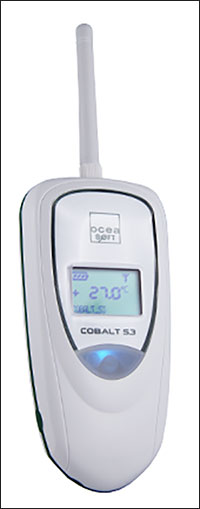Oceasoft, a French company that sells wireless sensor systems, recently announced its latest sensor product line, the Cobalt S3. Like Oceasoft’s first and second generation of wireless sensors, the S3 is available with integrated temperature, humidity, CO2, differential pressure, ambient light and voltage sensors, but unique to the S3 is its communication protocol. These new products send and receive data using the Sigfox ultra-narrow-band radio frequency protocol (meaning it relies on very narrow slices of the unlicensed Industrial Scientific Medical [ISM] frequency band). The Sigfox protocol is based on a European Telecommunications Standards Institute (ETSI) specification for a bi-directional data network enabling data to be transmitted over a long distance—up to 40 kilometers (24.9 miles)—while using very little power.
Sigfox, the French firm that developed the Sigfox protocol, is rolling out the required infrastructure to support these ultra-narrow-band devices, and thus far has installed its transceivers in France, Holland, the United Kingdom and Spain. It is also in the process of deploying its transceivers in San Francisco, and is conducting a pilot project in Graz, Austria. (Sigfox is one of a handful of companies looking to leverage low-throughput networks for IoT applications.)
According to Laurent Rousseau, Oceasoft’s CEO, 85 percent of the company’s customers are in the life-sciences sector and use the sensors to do such things as monitor the temperature of vaccines in storage or in transit, or to track CO2 or differential pressure levels, which are important metrics for applications in research laboratories. Its clients include pharmaceutical firms GlaxoSmithKline, Novartis and Sanofi. (In 2010, Oceasoft signed a distribution and branding agreement with California-based genetic testing and biomedical industry supplier Thermo Fisher Scientific, which helped Oceasoft grow its user base in North America.) However, Oceasoft also serves companies in the perishable-foods supply chain, as well as vendors that provide environmental monitoring services for cities or researchers. Rousseau is hopeful that the Cobalt S3 sensors and the long-range data transmission they support will allow Oceasoft to attract a greater number of customers in these two sectors.
“If you install pollution sensors in cities,” Rousseau says, “it is very convenient to use the Sigfox network to collect data from these sensors.” That’s because environmental monitoring requires that small packets of data be transmitted regularly over a long distance, which plays to the Sigfox network’s strengths, while avoiding its weakness: low bandwidth. While the Cobalt S3 sensor’s Sigfox radio module—which operates at 868 MHz in Europe and at 915 MHz in North America—can transmit a signal that can be received by a Sigfox gateway from as far as 500 kilometers (311 miles) away, it supports only small packets of data.
“We only transmit things like temperature readings, or pressure differentials, so we do not require large bandwidth,” Rousseau explains.
The alternative means for sending data over long distances—using a cellular network—requires users to pay for access to a cellular network. What’s more, Rousseau notes, since sensors communicating over a cellular network have a shorter range, using a cellular network would require that an end user purchase more sensors, compared with using Sigfox-compatible sensors and Sigfox’s network of access points. The Sigfox sensors will have a longer battery life, he says, and thus lower maintenance costs. According to Oceasoft’s calculations, overall hardware costs associated with a Sigfox-based sensor network are 30 percent lower than with a cellular-based network of comparable size, and the communication fees associated with operating are five times lower for a Sigfox system, since the Sigfox subscription costs are considerably lower.
In addition, Rousseau says, cellular networks have more bandwidth than the applications Oceasoft is targeting require. “If you consider cellular networks, especially the 4G network, they have been designed for voice, video or music—things that require large bandwidth,” he states.
With the Cobalt S3 devices, Oceasoft is also introducing a cloud-based data service that provides customers with a means of accessing and storing the collected sensor data. With cities increasingly interested in tracking environmental factors such as air quality in order to improve public health monitoring, Rousseau reports, or with farmers looking to collect granular data regarding humidity or temperature exposures to high-value crops such as grapes or nuts, the Cobalt S3 devices may find a number of fertile applications.
But Rousseau notes that Oceasoft has no intention of discounting the Cobalt 2, its second-generation wireless sensors that are already installed at many customer sites, and which use transceivers installed on premises to collect data from and communicate to the Oceasoft sensors. These transceivers are linked to a user’s network via an Ethernet or Wi-Fi link. “Some customers, either because of privacy concerns or because their networks are not cloud-oriented, don’t want to use the cloud,” he states. “So for them, Sigfox won’t work.” These customers need on-premises transceivers.
To address the needs of customers looking to track environmentally sensitive cargo in transit, Oceasoft offers a product known as Cobalt Emerald, which is a compact sensor that tracks temperature levels and communicates that information, via its Bluetooth Low Energy (BLE) radio module, to the smartphone of the driver transporting that cargo. If the sensor detects the shipment’s temperature is becoming sub-optimal, it issues an alert to the paired phone (it works only with Apple iOS-based devices). The sensor can collect up to 4,000 temperature readings, and can send each reading to the driver’s smartphone, where it is combined with the phone’s location, based on that phone’s GPS module. This data can then be uploaded to Oceasoft’s cloud-based servers, where the fleet manager can access it.
Aside from growing its product base, Oceasoft has seen its revenue increase at an average annual rate of 22 percent throughout the past five years. Looking to grow further, Oceasoft announced this week that it has filed paperwork for its planned initial public offering in France.


